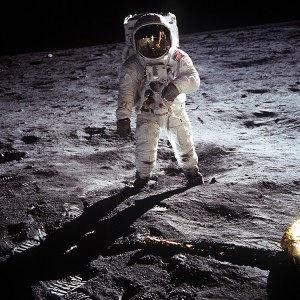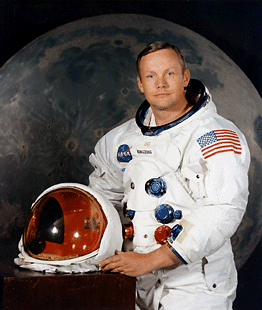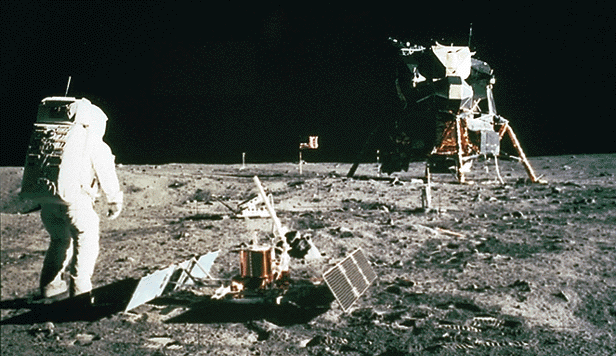Moon Landing: Apollo at 50
Friday, July 19th, 2019July 19, 2019
On July 20, 1969, 50 years ago tomorrow, the United States astronauts Neil Armstrong and Buzz Aldrin did what had seemed impossible not that long before: they landed on the moon. Watched by millions of people over a live television broadcast worldwide, Armstrong and Aldrin’s lunar first was the crowning moment of the National Aeronautics and Space Administration’s (NASA) Apollo space program.
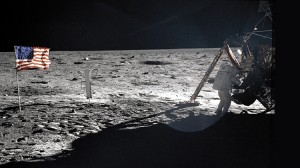
Astronaut Buzz Aldrin took this photo of Neil Armstrong working on a storage assembly on the lunar module, Eagle, on the surface of the moon in July 1969. Credit: NASA
In May 1961, President John F. Kennedy proposed landing astronauts on the moon by the end of the decade. This goal seemed out of the realm of possibility at the time. The United States was trailing the Soviet Union in the space race, a period of intense competition between the two countries to achieve supremacy in space exploration. The Soviet Union had already launched the first satellite (Sputnik in October 1957) and the first person (cosmonaut Yuri Gagarin in April 1961) into orbit around Earth. American efforts had been riddled with launch failures, and the greatest success at that time had been a brief suborbital flight (astronaut Alan Shepard spent a few minutes in space) shortly before Kennedy’s announcement. From the looks of things in 1961, if anyone was going to land on the moon before 1970, it would be a cosmonaut.
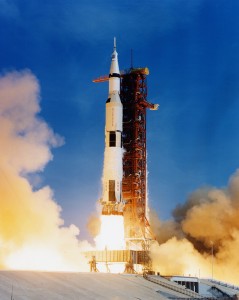
A NASA Saturn 5 rocket launches from Florida’s Kennedy Space Center on July 16, 1969, carrying the Apollo 11 astronauts who would land on the moon days later. Credit: NASA
NASA, however, accepted the challenge with intensity and enthusiasm. It wound down the initial Mercury space project and began the Gemini program. Gemini helped develop the technology and skills to travel to the moon. Astronauts were launched in pairs, and they practiced docking with other spacecraft—an important part of Apollo’s novel mission design. The astronauts also practiced more precise ocean landings, to gain skill for lunar touchdowns. Gemini ended in 1966 and was succeeded by Apollo.
The Apollo program started with disaster. In January 1967, a fire during a pre-launch test took the lives of astronauts Roger B. Chaffee, Virgil I. (Gus) Grissom, and Edward H. White II. After the accident, NASA engineers redoubled their focus on crew safety.
After several crewed and uncrewed Apollo test flights, NASA was ready to land the first people on the moon. On July 16, 1969, a Saturn 5 rocket, the most powerful rocket ever built, launched from Kennedy Space Center carrying the three astronauts of Apollo 11. After three days in transit, the mission entered into orbit around the moon. On July 20, Armstrong and Aldrin landed on the surface in the lunar lander module, named Eagle. Fellow astronaut Michael Collins stayed aboard a command module orbiting the moon.
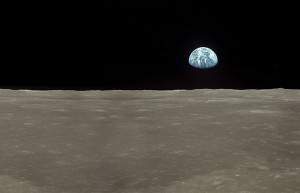
This photo taken during the Apollo 11 mission shows Earth rising above the surface of the moon. Credit: NASA
As the mission commander, Armstrong was the first person to leave the lunar module and set foot on the surface. Upon taking his first step onto the moon, he famously said: “That’s one small step for [a] man, one giant leap for mankind.” (The word “a” was lost in radio transmission.) Aldrin joined him on the surface about 20 minutes later. They explored the lunar surface for more than two hours, performing experiments, setting up scientific equipment, and collecting samples of the lunar surface. Then, they blasted off in the lunar module, reunited with Collins in orbit around the moon, and safely returned to Earth.
Armstrong, Aldrin, and Collins were greeted with honors and awards upon returning home, including the Presidential Medal of Freedom, one of the two highest civilian honors awarded by the U.S. government. (They were awarded the second highest honor, the Congressional Gold Medal, in 2011.) The lunar astronauts received huge parades in New York City, Chicago, and Los Angeles. They were celebrated in their home towns as well as at state dinners around the world.
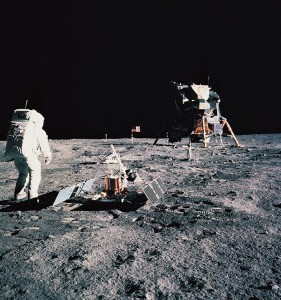
Astronaut Buzz Aldrin stands next to a seismograph on the lunar surface in July 1969. The lunar module, Eagle, stands in the background. Credit: NASA
Armstrong never became fully comfortable with the fame associated with being the first person to walk on the moon, refusing most interview requests until his death in 2012. Aldrin, however, enjoyed the spotlight and continues to be a prominent spokesperson for the advancement of human space exploration. Collins would have likely been selected to finally walk on the moon as the commander of Apollo 17—the last moon mission. But he retired from NASA after Apollo 11, happy to have been a vital—albeit relatively invisible—part of the first moon mission.
After six successful moon landings, Apollo was cancelled and NASA turned its attention to the development of the space shuttle. Humans have not left Earth’s orbit since since Apollo 17 in December 1972. That could change soon, however, as the United States and many countries and private companies are seeking to return to the moon in the near future. The American spacecraft company SpaceX is developing a rocket and lander intended to orbit and land on the moon. Another company, Blue Origin, is also developing rockets and landers with the ultimate goal of building a permanent settlement on the moon.

